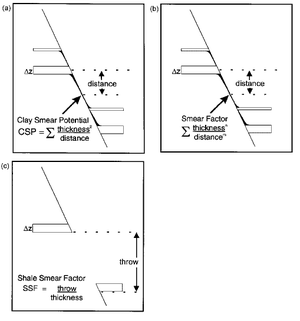Shale smear factor

Lindsay et al.[1] proposed a shale smear factor to constrain the likelihood of shale smear continuity. Based on their observations of abrasion smears in a lithified sequence, they define the shale smear factor (SSF) as (see Figure 1c)
SSF = fault throw/shale layer thickness
The shale smear factor remains constant between the offset terminations because it does not depend on smear distance (although lateral variations in fault throw would have a corresponding effect on the calculated SSF). SSF thus models the profile of abrasion-type smears. From a study of 80 faults (excluding composite smears), Lindsay et al. (1993) concluded that shale smears may become incomplete for an SSF greater than 7. Smaller values of SSF are more likely to correspond to continuous smears and therefore to a sealing layer on the fault surface. The values of SSF are not additive for compound smears because thin shales give higher SSF and dominate the sum. In such cases, a simple application of SSF values would take the minimum value (most sealing) from the relevant shale beds at that point on the fault.
- ↑ Lindsay, N. G., F. C. Murphy, J. J. Walsh, and J. Watterson, 1993, Outcrop studies of shale smear on fault surfaces: International Association of Sedimentologists Special Publication 15, p. 113-123.